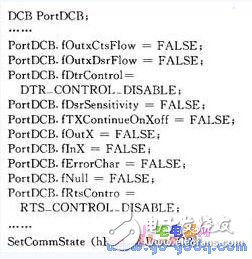In industrial control, it is often necessary to transmit the data collected by the single-chip microcomputer to the PC for processing and display, and send a control command to the single-chip microcomputer according to the processing result. Although serial communication is relatively slow, the transmission cost is low, it has sufficient bandwidth for monitoring and control, and there is no overly complicated codec, and the implementation of custom protocols is not complicated, so in industrial automation, communication and The application in the military and other fields is very extensive. With the wide application of Windows CE embedded operating system in industrial control, it is of great significance to design and implement serial communication between PC and MCU under Windows CE.
1Introduction to WindowsCE.NET4.2Windows CE is an operating system for mobile computing and embedded applications. Its outstanding advantages are modularity, customizability, completeness, real-time, communication capabilities and Win32-based application programming interface. Windows CE.N ET 4.2 is a successor to Windows CE 3.0, which was redesigned for the embedded market, providing a robust real-time operating system for quickly building the next generation of smart mobile and small memory footprint devices. He includes everything needed to create a custom device-based Windows CE.
2 serial communication technology under Windows CE.NET 4.2The serial port belongs to the stream interface device under Windows CE.NET 4.2 (hereinafter referred to as Windows CE). It is a combination of the serial device interface conventional I/O driver call and communication-related specific functions. A serial device is considered a conventional installable streaming device for opening, closing, and reading and writing serial ports. The serial port function of Windows CE is basically the same as the serial port function of Windows, but there are several points worth noting:
(1) Windows CE only supports the UnICode character set, so you must pay special attention when programming.
(2) Windows CE does not support overlapping I/O operations.
2.1 open and close the serial port
In all stream device drivers, CreateFile is used to open the serial port device. If this port does not exist, CreateFile returns ERROR_FILE_NOT_FOUND. Therefore, the user-specified port must be present and available, and follow the naming convention of the Windows CE stream interface device driver, that is, the port number to be opened by COM followed by a colon.
HANDLE hPort = CreateFile (_T("COM1:"),
GENERIC_READ|GENERIC_WRITE, 0, NULL,
OPEN_EXISTING, 0, NULL);
Closing the serial port is relatively straightforward. Calling the CloseHandle function closes an open serial port. CloseHandle has only one parameter, which is the handle returned when the CreateFile function is called to open the port. The method is as follows:
CloseHandle (hPort);
2.2 read and write serial port
Just as you use CreateFile to open a serial port, you can use the ReadFile and WriteFile functions to read and write to the serial port. Assuming that CreateFile has been successfully opened to open the serial port, simply call ReadFile to read the data from the serial port:
Since Windows CE does not support overlapping I/O operations, the fifth parameter must be set to NULL. Writing a serial port is also very simple. The calling process is as follows:
If a large amount of serial data is read and written from the main thread, the main thread will block because it waits for a relatively slow serial read or serial write operation, and cannot process other messages on the fly. It is therefore best to use a separate thread to read and write to the serial port.
2.3 Configuring the serial port
It is relatively simple to read and write the serial port, but it is also necessary to configure the port with the correct baud rate, character length, parity, transmission mode, etc., so that the port can communicate correctly. The serial driver can be configured by calling I/O Device Control (IOCTL), but this requires some underlying knowledge and a corresponding "embedded toolkit" (ETK) that the SDK cannot implement. In addition to this, there is an easier way to configure the serial port by calling the GetCommState and SetCommState functions. Since the configuration of the DCB structure of the port is large, it is troublesome to use. Incorrectly initializing the DCB structure is a common problem with configuring serial ports. If a serial communication function does not produce the expected effect, then the error is most likely an assignment in the DCB structure. When serial communication is realized with the single-chip microcomputer, since only the RXD, TXD and GND pins of the RS 232 serial port are used, and other pins are discarded, the DCB member variables should be set as follows, otherwise it cannot be Normal communication:

Zysen offers Coaxial Isolator, Connector SMA, N, BNC, 2.92mm or Tab are available. Customized frequency and optimized specifications available. Contact us with your requirement.
Isolator Coaxial,Coaxial Isolator,Microwave Isolator,Drop In Isolator
Chengdu Zysen Technology Co., Ltd. , https://www.zysenmw.com
